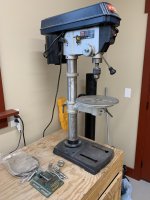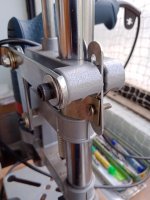Years ago I had a real Albrecht keyless chuck I fitted to an old drill press. No perceptible runout and drills never slipped. 25 years later I have another older china built drill press. I fitted a knockoff copy of the albrecht and runout and drills slipping. You really get what you pay for (sometimes I'm too cheap).
Yep. We had a cheap (as in $50) drill press where I used to work. It had a few mm of runout. It was pretty much useless as you never knew where the drill would touch down.
Tom
Tom
Our tool makers here will use a DRO on a vertical milling machine when they want to locate and drill holes precisely.
Favored machine is a ram turret type, originally a Bridgeport design.
Bridgeport sent it to Taiwan later on for outsourcing, now at least 4 of the Taiwanese makers build the machines in the Far East.
I have seen the original Bridgeport USA and Taiwan made machines at a tool room here near Baroda, where I live.
Favored machine is a ram turret type, originally a Bridgeport design.
Bridgeport sent it to Taiwan later on for outsourcing, now at least 4 of the Taiwanese makers build the machines in the Far East.
I have seen the original Bridgeport USA and Taiwan made machines at a tool room here near Baroda, where I live.
My benchtop jacobs can handle drills down to #80, so I luckily never needed that. (my watchmakers lathe can go to .004 inch drill bits, requiring I use my 60X stereoscope), but that chuck is a good option.I have a benchtop drill press and use one of these in it when using very small drills.
View attachment 1276120
The only difficulty is the runout for that chuck adapter cannot be well controlled. At the 3 to 5 mil level of runout, using anything between #60 to #80 is very dicey. Even with my drill press. I finally learned why I would have difficulty with small bits, it was all about the chip load problem and runout. Oh, and also the quality of the bits. I got tired of buying a dozen bits at a time to make sure I could finish a job. Runout, speeds, and feeds are very important.
W/r to runout, someone mentioned "looks good". I can't see 3 mil runout on a spinning drill bit, that is why I have measuring tools. No matter how good your tools are, you cannot be accurate until you can measure it.
edit: I had a unimat lathe for a while to cut my teeth on. The three jaw was quite worn, so I lapped it. Tried to get the three jaw runout down to decent levels, but found that while I could sometimes get a ground 1/4 inch rod to be in the 2 mil runout range, when I removed it and put it back in, it would not repeat. If I was able to turn all concentric features keeping it in the jaw, I could get good accuracy. But when I removed and returned, all bets were off.
Now, I use R8 or ER (32, 25, 16, and 11) collets for precision. My GF shakes her head when I complain about being off dimension by .0002 inches. Go figure...
For small bits, it is always important to go with the right speed, and to peck at the hole. Don't try to just blow through the metal, that only leads to heartache. And a return to McMaster-Carr.
John
Last edited:
John, yeah, my drill press is just a generic Taiwanese mass produced one that you see now made in China for all kinds of brands. It definitely has too much runout, but it was good enough for what I needed at the time. And it only cost $20, from a little old man, with limited use. The runout is manufacturing tolerances, not wear.
I have read extensively over at the Garage Journal forum about some of the really nice old drill presses (with minimal runout, being quality pieces well looked after) so recognised the shortcomings in mine. At the moment I have a shed I can't get into because it's so full of gear, so I need to build a new one before acquiring anything better!
As an aside, I'm sure you've noticed the biggest mistake most people make - too fast a rotation speed- especially in metal. Novices think 'high speed steel' and go flat out, overheating their drills, (without lube) and ruin them. I have a fine stone on one of my bench grinders and sometimes sharpen the drills for a workshop and many of them come here blue. I do tell them...
Cheers,
Stuey
I have read extensively over at the Garage Journal forum about some of the really nice old drill presses (with minimal runout, being quality pieces well looked after) so recognised the shortcomings in mine. At the moment I have a shed I can't get into because it's so full of gear, so I need to build a new one before acquiring anything better!
As an aside, I'm sure you've noticed the biggest mistake most people make - too fast a rotation speed- especially in metal. Novices think 'high speed steel' and go flat out, overheating their drills, (without lube) and ruin them. I have a fine stone on one of my bench grinders and sometimes sharpen the drills for a workshop and many of them come here blue. I do tell them...
Cheers,
Stuey
Did you use the same position for the Chuck key ? This makes a big difference on a worn Chuck. On a scroll lathe Chuck I always use the Chuck key in the position nearinst the round sticker on the face, on a Jacobs type drill Chuck I sometimes tighten in all three positions if the Chuck is badly worn (some chucks have a rare taper and are difficult to get off).when I removed it and put it back in, it
Yeah, but with any Jacobs chuck, even a new one, you just accept that there will be some runout.
But for a jacobs, I agree with you, I tighten it using all three positions.Did you use the same position for the Chuck key ? This makes a big difference on a worn Chuck. On a scroll lathe Chuck I always use the Chuck key in the position nearinst the round sticker on the face, on a Jacobs type drill Chuck I sometimes tighten in all three positions if the Chuck is badly worn (some chucks have a rare taper and are difficult to get off).
John
content lost....
The unimat has a 3 jaw but only two holes for using 4mm rods to close the chuck. So no three positions.
The spiral and jaw contact surfaces were obviously worn. The jaws could move out and in, not fully constrained so any wear related taper in the spiral wiped runout.
That is why I like either the MT3 collet adapter for my lathe, or the 4 jaw with the readouts.
John
The unimat has a 3 jaw but only two holes for using 4mm rods to close the chuck. So no three positions.
The spiral and jaw contact surfaces were obviously worn. The jaws could move out and in, not fully constrained so any wear related taper in the spiral wiped runout.
That is why I like either the MT3 collet adapter for my lathe, or the 4 jaw with the readouts.
John
Gracious offer but I’m no longer lookingI have a Ryobi I can sell you, and I wouldn’t mind a drive across the PNW to deliver.
View attachment 1280879
I had a TOYO lathe with the same style of Chuck, instead of having two sets of jaws (inside and out), the jaws were reversible, meaning that the teeth that engage in the scroll were compromised - I wonder if the jaws of the Unimat are the same, causing increased wear.content lost....
The unimat has a 3 jaw but only two holes for using 4mm rods to close the chuck. So no three positions.
The spiral and jaw contact surfaces were obviously worn. The jaws could move out and in, not fully constrained so any wear related taper in the spiral wiped runout.
That is why I like either the MT3 collet adapter for my lathe, or the 4 jaw with the readouts.
John
I tried to fix the rotational wobble by attaching a collar and fixing a plate, both mild steel.Best I could do. The stem is of the adjustable type -two pieces. One part waits for a light duty lathe project since the stand is now very stable. The other part is attached with a 10mm bolt as shown - aluminum plate, nut, washer, stem, washer, nut, plate. The plates are attached to the stand with small bolts, then everything is aligned and tighten. You may want to control wobbling with the stem's bolts but in my case it wasn't necessary. And a photo of the quick release that makes height adjustment easy.
Attachments
- Home
- Design & Build
- Equipment & Tools
- Small drill press

